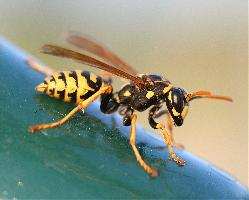
Weights and measures
| Length | 40 mm |
|---|
Animal description
The Asian giant hornet, scientifically named Vespa mandarinia, is a remarkable species of hornet native to East Asia and parts of the Russian Far East and the Indomalayan region. This species has garnered attention due to its size, behavior, and impact on ecosystems and human activities. It is the largest hornet species in the world, with queens reaching lengths of up to 5 centimeters (2 inches), and workers slightly smaller, averaging around 3.5 centimeters (1.4 inches). Their presence is formidable, not just in size but in their distinctive coloring; they possess a striking appearance with a bright yellow-orange face, a black and yellow striped abdomen, and deep, dark eyes that add to their intimidating demeanor.The Asian giant hornet is a highly social insect, living in colonies that can number in the hundreds. These colonies are established annually in the spring by a single fertilized queen who emerges from hibernation, finds a suitable nesting site, and begins to lay eggs. The first brood of workers, once matured, takes over the tasks of expanding the nest, foraging for food, and caring for subsequent broods of eggs, larvae, and pupae laid by the queen.
Their diet is predominantly protein-based, feeding on other insects such as beetles, mantises, and particularly other species of bees and wasps. One of their most feared behaviors is the coordinated attack on honeybee hives. A small group of Asian giant hornets can decimate an entire hive of honeybees in a matter of hours, killing the adults and taking the larvae and pupae as food for their own young. However, in their native habitats, some honeybee species have developed defensive strategies against these attacks.
The venom of the Asian giant hornet is potent and contains a complex cocktail of chemicals that can cause significant pain and tissue damage to humans and other animals. While they are not generally aggressive towards humans unless provoked or their nest is threatened, their stings can be extremely painful and, in rare cases, lethal—particularly if an individual is allergic or receives multiple stings.
The Asian giant hornet has also been a subject of concern due to its recent appearances outside of its native range, notably in North America. Their presence in non-native regions poses a threat to local ecosystems, particularly through the potential decimation of bee populations, which are vital for pollination and maintaining the health of local flora.
In their native environments, these hornets play a role in the natural balance by controlling the populations of other insects, thus demonstrating the complex interdependencies within ecosystems. However, their introduction into non-native environments highlights the challenges and consequences of invasive species on global biodiversity.
The Asian giant hornet, with its imposing size, distinctive appearance, and powerful venom, is a fascinating yet formidable creature. Its behaviors and impacts on ecosystems serve as a reminder of the intricate relationships between species and the importance of maintaining biodiversity and ecological balance.
Similar Animals
New photos of animals
Top 10 animals
- Dolphin gull (Leucophaeus scoresbii)
- Diana monkey (Cercopithecus diana)
- Moustached guenon (Cercopithecus cephus)
- Galápagos tortoise (Geochelone nigra complex)
- Japanese macaque (Macaca fuscata)
- Stone loach (Barbatula barbatula)
- Russian tortoise (Testudo horsfieldii)
- Greek tortoise (Testudo graeca)
- Common flying dragon (Draco volans)
- Vendace (Coregonus albula)


